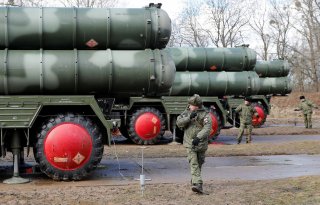How Turkey Could Get Back into the F-35 Program: America Buys Their Russian S-400 Air Defense System.
Oh, and Putin won't like that one bit.
In an amendment to the 2021 National Defense Authorization Act submitted by Senator John Thune (R-S.D.), outlined how the United States could be able to buy Turkey’s S-400 air defense system.
Turkey purchased the Russian-made S-400 system in defiance of the United States and NATO, with which the system is incompatible, despite strong warnings from the United States. Despite the warnings, Turkey took delivery of the system earlier this year.
The S-400 is one of Russia’s premier missile defense systems. Depending on the type of target and the type of missile used, the S-400 can detect targets up to 600 kilometers or about 375 miles away, though maximum targeting distance is somewhat less at 400 kilometers, or about 250 miles.
The S-400 is highly customizable, depending on the threat it is likely to counter. Depending on the missile package, it can be optimized for short- medium- and long-range targets, such as high-flying bombers, or much faster ballistic missiles.
American and NATO Allies expressed concerns that the Russian system’s tracking radar could gain insights on the F-35 stealth fighter’s flight characteristics and radar signature, potentially uncloaking the stealth characteristics of NATO’s newest fighter. Additionally, servicing the made-in-Russia air defense system could require on-site Russian technicians who may have access to NATO air defense data. The repercussions for Turkey are significant.
In March, Secretary of Defense Mark Esper announced the Turkish expulsion from the F-35 program. Turkish participation in the program included both Turkish pilot training and production of fuselage and landing gear parts—some of which were manufactured exclusively in Turkey. Since Turkey’s ejection from the program, F-35 production has slowed, as American manufactures have struggled to make up for lost production capacity.
Senator Thune’s amendment simply states, “such sums as may be necessary are authorized to be appropriated for the Army for ‘‘Missile Procurement, Army’’ for the purchase of an S-400 missile defense system,” though the deal would be contingent upon approval from the Government of Turkey, the U.S. Secretary of Defense, and the U.S. Secretary of State.
These three authorities would have to certify that the money Turkey receives for their S-400 would not be used to “purchase or otherwise acquire military apparatus deemed by the United States to be incompatible with the North Atlantic Treaty Organization,” a nod to NATO’s foremost concern about the Russian air defense system.
The move may be intended as a way for Turkey to save face. Secretary of Defense Esper made clear that Turkey cannot have both the S-400 system and the F-35 stealth fighter, even if the Russian air defense system remained in inactive storage. Turkey had planned to buy up to 100 F-35As, the conventional landing F-35 variant.
If the United States is able to buy the S-400 missile defense system, its capabilities could be better understood and exploited to protect the F-35 and F-22 stealth fighters from Russian radar. Though Senator Thune established the legal pathway for acquiring the S-400, it remains to be seen if all parties will sign off to the deal—especially Turkey. Having been fully aware of the risks and going ahead with the air defense system anyway, it seems unlikely that Turkey would acquiesce to the American offer now.
Caleb Larson is a defense writer with the National Interest. He holds a Master of Public Policy and covers U.S. and Russian security, European defense issues, and German politics and culture.
Image: Reuters

